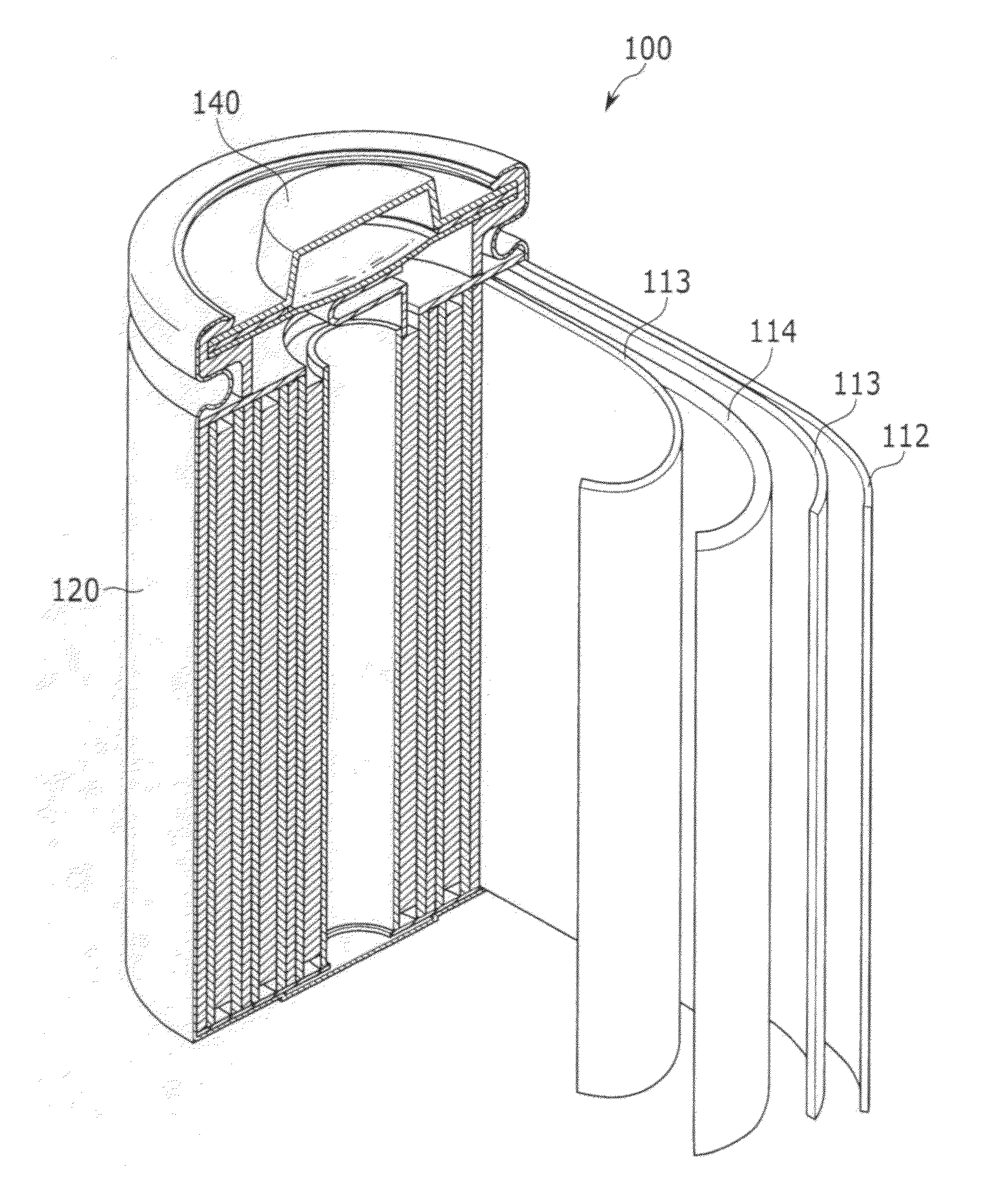Rechargeable lithium battery including negative active material
- Summary
- Abstract
- Description
- Claims
- Application Information
AI Technical Summary
Benefits of technology
Problems solved by technology
Method used
Image
Examples
example
Preparation Examples 1 to 3
Preparation of Negative Active Material
[0075]A silicon-based negative active material coated with Ag was prepared by dispersing a SiO material in a nano Ag dispersion solution as follows.
[0076]1. The SiO material is made by Japanese Shinetsu silicon, in which nano Si grains are dispersed in a silica SiO2 matrix. The SiO material has an atomic ratio of Si:SiO2=1:1 and thus, represented as SiO. It may be represented by a SiOx material with x=1. FIG. 3 provides the TEM photograph of the SiO material, in which Si is dispersed in a silica matrix. The Si has a size (ranging) at 10 nm or 20 nm or between 10 nm and 20 nm.
[0077]The Ag dispersion solution was prepared by dispersing nano Ag powder in ethanol. Specifically, about 10 g of Ag nanopowder was mixed with about 190 g of ethanol, and dispersed using an ultrasonic wave dispersing device to the Ag dispersion solution.
[0078]2. About 90 g of the SiO material was put in the Ag dispersion solution. The resulting p...
preparation example 4
Preparation of Carbon-coated Negative Active Material
[0083]A negative active material was prepared to have a 1 μm-thick carbon coating layer as, e.g., shown in FIG. 1B instead of an Ag coating layer as, e.g., shown in FIG. 1A. It was prepared in a CVD method. About 10 g of SiO powder were put in a 3 inch spinnable circular quartz tube furnace and heated up to about 1000° C. While the reactant was maintained at about 1000° C., methane gas (CH4) was flown in at a speed of about 20 sccm (standard cubic centimeters per minute) for one hour to uniformly coat about 1 um-thick carbon on the SiO powder. The quartz tube was specially fabricated to prevent the powder from being spilled out during the spinning. The tube was spun to uniformly coat a carbon layer.
[0084]In Preparation Example 4, since the heat treatment was performed at a high (e.g., maximum) temperature of about 1000° C., the SiO active material was expected to have an increased Si grain size. Its TEM shows that the Si grains ha...
examples 1 to 3
Fabrication of Rechargeable Lithium Battery Cells
[0086]An 18650 circular cell was fabricated by using the negative active materials according to Preparation Examples 1 to 3. A negative electrode was prepared by using an active material composition having a weight ratio among an active material:a conductive material:a binder=80:10:10 in a solvent. The conductive material was Denka black, the binder was PI (polyimide), and the solvent was NMP (N-methyl-2-pyrrolidone). As for a positive electrode, LiCoO2 was used. As shown in FIG. 2, a separator was inserted between the negative electrode and the positive electrode. The resulting product was spiral-wound and housed in a can. Then, an electrolyte solution was implanted in the can, and the can was sealed to fabricate a cell (battery cell). The electrolyte solution was prepared by dissolving 1.5M LiPF6 in a mixed solvent of EC (ethylenecarbonate), EMC (ethylmethylcarbonate) and DMC (dimethylcarbonate) (3:3:4 volume ratio) and adding FEC (...
PUM
 Login to View More
Login to View More Abstract
Description
Claims
Application Information
 Login to View More
Login to View More - R&D
- Intellectual Property
- Life Sciences
- Materials
- Tech Scout
- Unparalleled Data Quality
- Higher Quality Content
- 60% Fewer Hallucinations
Browse by: Latest US Patents, China's latest patents, Technical Efficacy Thesaurus, Application Domain, Technology Topic, Popular Technical Reports.
© 2025 PatSnap. All rights reserved.Legal|Privacy policy|Modern Slavery Act Transparency Statement|Sitemap|About US| Contact US: help@patsnap.com



